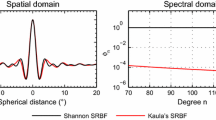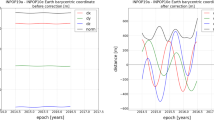Abstract
For satellites in orbits, most perturbations can be well modeled, however the inaccuracy of the atmospheric density model remains the biggest error source in orbit determination and prediction. The commonly used empirical atmospheric density models, such as Jacchia, NRLMSISE, DTM, and Russian GOST, still have a relative error of about 10%–30%. Because of the uncertainty in the atmospheric density distribution, high accuracy estimation of the atmospheric density cannot be achieved using a deterministic model. A better way to improve the accuracy is to calibrate the model with updated measurements. Twoline element (TLE) sets provide accessible orbital data, which can be used in the model calibration. In this paper, an algorithm for calibrating the atmospheric density model is developed. First, the density distribution of the atmosphere is represented by a power series expansion whose coefficients are denoted by the spherical harmonic expansions. Then, the useful historical TLE data are selected. The ballistic coefficients of the objects are estimated using the BSTAR data in TLEs, and the parameterized model is calibrated by solving a nonlinear least squares problem. Simulation results show that the prediction error is reduced using the proposed calibration algorithm.
Similar content being viewed by others
Change history
11 February 2022
A Correction to this paper has been published: https://doi.org/10.1007/s42064-022-0136-2
References
Shanklin, R. E., Lee, T., Samii, M., Mallick, M. K., Cappellari, J. O. Comparative studies of atmospheric density models used for earth satellite orbit estimation. Journal of Guidance, Control, and Dynamics, 1984, 7(2): 235–237.
Jacchia, L. G. Revised static models of the thermosphere and exosphere with empirical temperature profiles. SAO Special Report No. 332. Smithsonian Institution Astrophysical Observatory, 1971.
Hedin, A. E. MSIS-86 thermospheric model. Journal of Geophysical Research: Space Physics, 1987, 92(A5): 4649–4662.
Bruinsma, S., Thuillier, G., Barlier, F. The DTM2000 empirical thermosphere model with new data assimilation and constraints at lower boundary: Accuracy and properties. Journal of Atmospheric and Solar-Terrestrial Physics, 2003, 65(9): 1053–1070.
Cefola, P., Volkov, I. I., Suevalov, V. V. Description of the Russian upper atmosphere density model GOST2004. In: Proceedings of the 37th COSPAR Scientific Assembly, 2008: 476.
Vallado, D. A. Fundamentals of Astrodynamics and Applications. Springer Science & Business Media, 2001: 524–542.
Doornbos, E., Klinkrad, H., Visser, P. Atmospheric density calibration using satellite drag observations. Advances in Space Research, 2005, 36(3): 515–521.
Doornbos, E., Klinkrad, H., Visser, P. Use of two-line element data for thermosphere neutral density model calibration. Advances in Space Research, 2008, 41(7): 1115–1122.
Liu, H., Luhr, H., Henize, V., Kohler, W. Global distribution of the thermospheric total mass density derived from CHAMP. Journal of Geophysical Research: Space Physics, 2005, 110(A4): A04301.
Bruinsma, S., Tamagnan, D., Biancale, R. Atmospheric densities derived from CHAMP/STAR accelerometer observations. Planetary and Space Science, 2004, 52(4): 297–312.
Shoemaker, M. A., Wohlberg, B., Koller, J. Atmospheric density reconstruction using satellite orbit tomography. Journal of Guidance, Control, and Dynamics, 2015, 38(4): 685–698.
Picone, J. M., Hedin, A. E., Drob, D. P., Aikin, A. C. NRLMSISE-00 empirical model of the atmosphere: Statistical comparisons and scientific issues. Journal of Geophysical Research: Space Physics, 2002, 107(A12): SIA 15-1–SIA 15-16.
Hinks, J. C., Psiaki, M. L. Simultaneous orbit and atmospheric density estimation for a satellite constellation. In: Proceedings of the AIAA/AAS Astrodynamics Specialist Conference, Guidance, Navigation, and Control and Co-located Conferences, 2010: AIAA 2010-8258.
King-Hele, D. G. Satellite Orbits in an Atmosphere: Theory and Application. Springer Science & Business Media, 1987: 164–165.
Sang, J., Bennett, J. C., Smith, C. H. Estimation of ballistic coefficients of low altitude debris objects from historical two line elements. Advances in Space Research, 2013, 52(1): 117–124.
Hoots, F. R., Roehrich, R. L. Models for propagation of NORAD element sets. Spacetrack Report No. 3. Defense Technical Information Center, 1980.
Author information
Authors and Affiliations
Corresponding author
Additional information
Yuan Ren joined the Department of Earth and Space Science and Engineering of York University as the research fellow in September 2011. Prior to this, he was a Marie-Curie experienced researcher at the Department of Applied Mathematics I, Polytechnic University of Catalonia, Spain, from 2008 to 2010, and an assistant professor at the School of Aeronautics and Astronautics, Shanghai Jiao Tong University, China, from 2007 to 2008. He received his B.Eng., M.Eng., and Ph.D. degrees all from Harbin Institute of Technology, China, in 2002, 2004, and 2007, respectively. His current research interests are orbital dynamics, three-body and multi-body problem, trajectory optimization and navigation.
Jinjun Shan joined the Department of Earth and Space Science and Engineering of York University as an assistant professor in July 2006. He was promoted to associate professor in July 2011, and full professor in July 2016. Dr. Shan was awarded the Alexander von Humboldt (AvH) Research Fellowship for Experienced Researchers and JSPS Invitation Fellowship in 2012. He is a senior member of IEEE and AIAA, and a professional engineer in Ontario since 2007. His current research interests are dynamics, control and navigation, smart materials and structures, multi-agent system, and orbit dynamics. He is the founding director of Spacecraft Dynamics Control and Navigation Laboratory (SDCNLab) of York University.
Rights and permissions
About this article
Cite this article
Ren, Y., Shan, J. Calibration of atmospheric density model using two-line element data. Astrodyn 2, 13–24 (2018). https://doi.org/10.1007/s42064-017-0008-3
Received:
Accepted:
Published:
Issue Date:
DOI: https://doi.org/10.1007/s42064-017-0008-3




